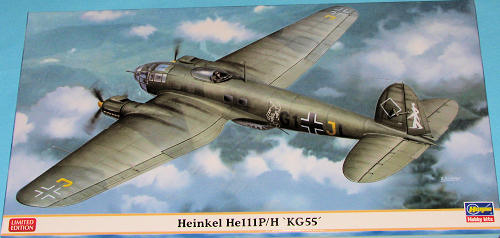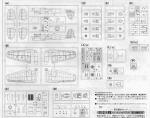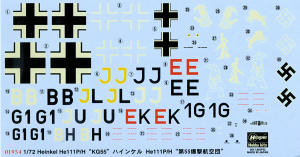
Hasegawa 1/72 He-111P/H 'KG 55'
| KIT #: | 01954 |
| PRICE: | $42.35 from www.greatmodels.com (53.00 SRP) |
| DECALS: | Three options |
| REVIEWER: | Scott Van Aken |
| NOTES: | Limited Edition |

| HISTORY |
Despite this, many different variants were developed and the He-111 was in production for most of the war, until all bomber production stopped during late 1944 so that more fighters could be built to try to combat the Allied air onslaught. These planes were used as mine-sweepers, cargo aircraft, transports for high-ranking personnel, unit hacks and a number of other various and sundry duties. A few were exported and Spain developed a production line for them, though they had to switch to Merlin engines after their supply of Daimler-Benz engines ran out in the late 1940s.
| THE KIT |
 This
particular kit concentrates on the Battle of Britain era P-2 and H-2
versions. The major difference is that the P-2 has Daimler Benz engines
while the H-2 has the Junkers power plant.
This
particular kit concentrates on the Battle of Britain era P-2 and H-2
versions. The major difference is that the P-2 has Daimler Benz engines
while the H-2 has the Junkers power plant.
As usual, all the sprues save the clear bits are in one bag. This resulted in some damage to parts as they rubbed together during shipment. There are a LOT of sprues in this one and if you have built any of the Hasegawa twins, then you have a good idea of what you are in for. First thing that grabbed me is that this one actually has the interior bomb rack and you can pose the bomb bay doors open. A first as far as I know with regard to the bay doors in 111 kits. Thanks to the way the sprues are set up, you actually get two internal bomb racks so you can use the second on your Roden kit! No external bomb racks on this one as those were not used until later in the war. The cockpit is quite complete and provides an instrument decal only for the main instrument panel. On the inside of the rest of the interior is framing as you can see some of this through the various windows.
Depending on the aircraft you are building, you have the options of
different engines, or different exhaust. Aside from engines there was
little difference between the two variants. You do have to drill a few holes for various bits as
well. The engines use poly caps so you can just push on the props at the
end of construction. I noticed a tiny bit of flash on the prop blades and
the wing ejector marks almost punched through the wing, leaving visible
marks on the outside of the wing. These may disappear under a
 coat of
paint.
coat of
paint.
The instructions are the usual excellent ones we have come to expect from Hasegawa. Colors are given in generic and Gunze shades with RLM numbers provided where needed. All of them are in RLM 70/71/65. Two are from KG.55 with the third option from KG.27. The Jumo powered plane is from 1./KG 55 while the DB powered planes are from 3./KG 55 and 2./KG 27. . All three aircraft have artwork on the fuselage sides or tail. This is in white. Decals are nicely printed, but have reverted to the off white of days of old, so one may wish to look into aftermarket if that is an issue. As usual, the instruments are decals as well.
| CONCLUSIONS |
It really is an excellent kit and I doubt if it will be surpassed any time soon. I built the initial boxing when it first came out in 2004 (yes it has been that long ago) and can attest to how nice it is.
December 2011
I got this at GreatModels, where you can find many cool kits, accessories and books.
If you would like your product reviewed fairly and fairly quickly, please contact the editor or see other details in the Note to Contributors.